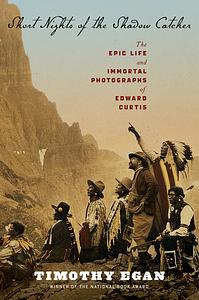You need to sign in or sign up before continuing.
Take a photo of a barcode or cover
National Book Award winning author Timothy Egan brings to our attention a man who in the early part of the last century captured through his haunting photographs, the faces and culture of the Native American Indian before they changed beyond recognition. That man was photographer Edward Curtis. This book will appeal to photography and history buffs alike, as well as those who want a closer look at the cultural conflicts and policy consequences of that time. -- Amy O.
adventurous
informative
inspiring
sad
fast-paced
I would happily read or listen to any book written by Timothy Egan. His research is excellent, he writes like a dream and he picks fascinating subjects. THE BIG BURN about Theodore Roosevelt and Gifford Pinchot is riveting, especially in its descriptions of the huge 1910 forest fire that swallowed up whole towns in a matter of hours. THE WORST HARD TIME shed new light on the Dust Bowl and introduced us to individuals whose families are still scarred by that terrible blight on the land, brought on by human greed and waste. This one tells the story of Edward Curtis, the remarkable, turn of the century photographer who set out to capture the lives of every North American Indian tribe before their lives and customs were lost to history. He came from nothing, managed to enlist notable figures such as TR and J. P. Morgan in his project and then died a pauper.
All of these, as with most non-fiction books I read, I've listened to in audiobook form. They are well read without being "over performed." In each case, the reader gets out of the way and lets the words speak for themselves. As I've narrated three of my own books on audio, I know how hard that can be.
All of these, as with most non-fiction books I read, I've listened to in audiobook form. They are well read without being "over performed." In each case, the reader gets out of the way and lets the words speak for themselves. As I've narrated three of my own books on audio, I know how hard that can be.
Worth the read - a fascinating look at a very unusual character.
This was fascinating not just for discovering someone who was a tremendous artist, but for learning that there were so many people in that time who bucked the conventional view of native Americans as savages. And that he (and others) lived out their convictions for decades, against the flow, to record the humanity and grace of people that everyone else wanted to forget or ignore. It's a remarkable story, and told so well that I couldn't put it down.
adventurous
informative
slow-paced
informative
slow-paced
I’m not sure how to rate this book. I feel like Evan’s scholarship is amazing and quite thorough. I do feel like he admired Curtis and I find Curtis to be more of a morally grey person. He did try to preserve knowledge but did so in a deceitful way that left me the reader feeling uncomfortable. There should be boundaries and knowledge without bounds feels unethical when it is knowledge of others. The fact that he exposed injustices is great but that he caused the deaths of others due directly to his work is not wonderful. Also I knew nothing of Curtis before this book.
Interesting subject but woefully overwritten, and far too many wordy descriptions of Curtis' photos with poor reproductions of the photos themselves.
I listened to an audio version of this book but didn't like the reader. Maybe I would have liked it more if I read the text. Interesting story but I was more intrigued by the Indian stories than Curtis's story.
This was an excellent read about an artist and researcher that I had always wanted to know more about. I think that Egan did a really good job of narrating the course of events, capturing the feelings and motivations of all involved, interpreting the art produced, and addressing some of the criticisms that Curtis's work has faced over time. I learned quite a lot during the course of reading, and want very badly to have the chance to read some of the Curtis volumes. I can't remember the last time a work of non-fiction (or fiction for that matter) almost moved me to tears on a couple occasions. Pretty much nobody who put their heart and soul into Curtis's life work - from Curtis himself, to his team of researchers and technicians, to the Native Americans he worked with and photographed - had the chance to live long enough to see the result of all their sacrifice. Thankfully they persevered. As Egan notes, many tribes have been able to use material collected by Curtis to reclaim aspects of their cultural identity that were almost successfully repressed by the US Government and missionary activities. I've always had a healthy admiration for the art of Curtis, but this book opened my eyes to the wide-reaching impact of all that he and his colleagues accomplished. All that aside, he was also a complete badass, climbing mountains like nothing, living most of his life under the open sky, and doing everything he did out of a personal passion without even a whiff of monetary reward. He was certainly a visionary of his time, and worked with some amazing like-minded individuals in both the Anglo and Native American communities.

